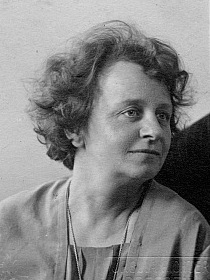Etha Richter

Etha Irmgard Christine Richter (born February 4, 1883 in Dresden ; † March 12, 1977 there ) was a German sculptor and draftsman . She is considered the first animal sculptor in Germany.
Life
Richter was born in Dresden as the oldest of five daughters of a pianist, and one of her sisters was the photographer Ursula Richter . She attended school in Radebeul and Dresden; she began to draw early on. She was particularly interested in animals, which she studied at the Dresden Zoo, among other places . As a woman, she was not admitted to study at the Dresden Art Academy . Instead, she went to the Dresden University of Veterinary Medicine for three years , where she was the first female student. Around 1900 she also attended lectures by Georg Treus at the TH Dresden , who lectured on the history of sculpture. Treu, who had supported her for some time and encouraged her to model, recommended her to Robert Diez , who taught her privately and later supported her acceptance into the Saxon Artists' Association. The first purchases of their animal sculptures by the state date back to 1903.
In addition to her work as an animal sculptor, Richter gave drawing lessons from 1920 to 1929 at the art school Der Weg , which was directed by Edmund Kesting . In 1927 she married Hans Richter (1880-1946), who worked as a veterinarian and animal anatomist. Due to her husband's scientific position, Richter went with him to Dorpat in 1933 and to Ankara the following year , where she taught drawing animals at the Yüksek Ziraat Enstitüsüdür YZE agricultural college. The couple stayed in Ankara until 1940 and then returned to Dresden. After 1941 Richter exhibited her works at numerous major exhibitions, including in Berlin, Dresden and Munich - for example, every year from 1940 to 1944 at the Great German Art Exhibition . Her studio was destroyed in the air raids on Dresden in February 1945 and Richter lost almost 500 of her works in the process. After the war she worked from 1946 to 1963 as a lecturer for drawing and sculpture at the Volkshochschule Dresden and also gave private lessons. Inge Thiess-Böttner , Eberhard Wolf and Rolf Winkler were among her students . In addition to numerous animal sculptures, including in porcelain (including for the Unterweißbacher workshops for porcelain art ), bronze, plaster and metal, Richter designed a portrait medallion by Käthe Kollwitz in 1947 for the Käthe Kollwitz memorial stone in Moritzburg , which was executed by the Dresden sculptor Rudolf Kreische has been.
In 1968 Richter was made an honorary member of the Association of Visual Artists of the GDR . She last lived - widowed since 1946 - at Borsbergstrasse 11 in Dresden and died in 1977. She was buried next to her husband in the Tolkewitz urn grove .
In 2015, a street in Dresden-Striesen was named after her.
literature
- Judge, Etha . In: Ernst-Günter Knüppel: Robert Diez. Sculpture between Romanticism and Art Nouveau . Leipziger Universitätsverlag, Leipzig 2009, pp. 185–187.
- Judge, Etha . In: Robert Thoms: Great German Art Exhibition Munich 1937–1944. Directory of artists in two volumes, Volume II: Sculptors . Neuhaus Verlag, Berlin 2011, ISBN 978-3-937294-02-5 , p. 58.
Web links
- Biographies of Dresden people (PDF file; 184 kB)
- Works and portraits of Etha Richter in the Deutsche Fotothek
- Anne Spitzer: Judge, Etha Irmgard Christine . In: Institute for Saxon History and Folklore (Ed.): Saxon Biography .
Individual evidence
- ^ Robert Thoms: Great German Art Exhibition Munich 1937-1944. List of artists in two volumes, Volume II: Bildhauer Berlin 2011, p. 58.
| personal data | |
|---|---|
| SURNAME | Judge, Etha |
| ALTERNATIVE NAMES | Judge, Etha Irmgard Christine |
| BRIEF DESCRIPTION | German sculptor and draftsman |
| DATE OF BIRTH | February 4, 1883 |
| PLACE OF BIRTH | Dresden |
| DATE OF DEATH | March 12, 1977 |
| Place of death | Dresden |

